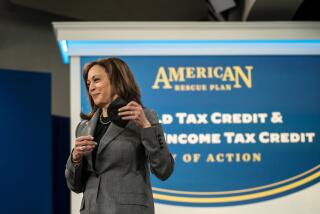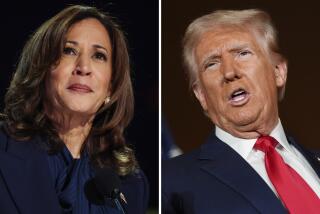At Odds on Business Levies : Tax Bill Leaders Pledge to Aim for 27% Top Rate
WASHINGTON — Leading House and Senate architects of tax-overhaul legislation, meeting on the eve of a monthlong effort to meld their bills into one, pledged Wednesday to keep the top personal tax rate close to the Senate’s 27% ceiling but indicated differences over tax changes worth billions of dollars to businesses.
“I’d stay at 27%,” said House Ways and Means Committee Chairman Dan Rostenkowski (D-Ill.), who had shepherded a 38% maximum rate through the House in Democratic tax legislation passed last fall. “I have no problem with that.”
He commented as the House adopted a Republican-sponsored resolution to instruct House negotiators on the conference committee, which will settle differences between the Senate and House bills, to aim for rates as low as those in the Senate bill. Rostenkowski defused a potentially awkward situation by going along with the resolution, which is non-binding.
‘Everybody Took a Hit’
Senate Finance Committee Chairman Bob Packwood (R-Ore.), chief architect of the Senate bill, and Rostenkowski appeared in a public television interview Wednesday.
They expressed general accord, but Rostenkowski took a swipe at the Senate tax plan by defending House decisions to curb deductions for a wide variety of industries rather than focusing almost exclusively on real estate tax shelters, as the Senate did. In the House bill, Rostenkowski said, “everybody took a hit, but we didn’t put anybody out of business.”
Meanwhile, the House named 11 of its members to the conference to negotiate with the 11 Senate conferees selected Tuesday.
The House delegation will include seven Democrats--Rostenkowski, Reps. Pete Stark of Oakland, Charles B. Rangel of New York, J.J. Pickle of Texas, Marty Russo of Illinois, Richard A. Gephardt of Missouri and Don J. Pease of Ohio. Rostenkowski, in picking the Democratic conferees, bypassed several more senior members to assemble a team of lawmakers considered loyal to him.
The four Republicans, named on the basis of seniority, are John J. Duncan of Tennessee, Bill Archer of Texas, Guy Vander Jagt of Michigan and Philip M. Crane of Illinois.
Billions at Stake
The general outlines of a final tax package have emerged in the last couple of weeks of pre-conference sparring, but billions of dollars are at stake in the details of the complex negotiations.
“It’s just like a Monopoly game,” Stark said. “But we’re playing it with real money.”
Ordinary taxpayers may pay the keenest attention to the fates of three popular deductions that largely benefit middle- and upper-income individuals: deductions for individual retirement accounts, consumer interest payments and state sales taxes.
The House bill allows taxpayers to deduct from their income up to $2,000 in annual IRA contributions unless they contribute to a 401(k) retirement account. The Senate, however, voted narrowly to grant that deduction only to those taxpayers who are not covered by a company-sponsored pension plan.
Senate leaders have all but conceded that their version of the IRA deduction will not pass political muster, but there is little chance that the full write-off for IRAs will be retained for all taxpayers.
The Senate bill is stingier than the House version when it comes to consumer interest, which is now fully deductible for the mostly middle- and upper-class taxpayers who itemize.
House Bill More Generous
The Senate would eliminate the deduction entirely. The House bill, on the other hand, would limit it to $10,000 ($20,000 for a joint return) more than the taxpayer’s declared earnings from investments--a ceiling that most taxpayers would never approach.
The two sides will also tangle over the deductibility of sales taxes for those who itemize. The House would preserve the full write-off as it exists in current law, but the Senate would drastically limit it under a complex formula pegged to state income tax payments.
Corporations and their Washington representatives, meanwhile, will labor to preserve the Senate bill’s kinder treatment of businesses. The Senate legislation would raise corporate income taxes by roughly $100 billion over five years, but the five-year tax increase under the House bill has been estimated as high as $160 billion.
In a related matter, a nonpartisan tax-research group contended Wednesday that the average corporate income tax burden fell sharply in 1985, with at least 95 major companies reaping profits but paying no federal income taxes.
Some Firms Get Refunds
A number of the 95 firms actually received refunds from the Treasury by employing deductions and other tax breaks to turn their profits into losses, the nonprofit group, Tax Analysis, said. The Washington-based institute publishes regular briefings on tax issues.
Using Securities and Exchange Commission records and other public data, the group concluded that the average income tax burden for the 604 largest profitable U.S. firms dropped from 23.2% of profits in 1984 to 18.7% last year. The statutory tax rate is 46%.
Tom Field, director of Tax Analysis, said that the study underscored the long-held belief that the current tax laws benefit heavy industries, with their write-offs and credits for machinery purchases, more than labor-intensive service businesses.
“There is no question but that the tax reform . . . would move our corporate tax system in the direction of greater equality of treatment,” Field said. “Corporate tax managers will have to work harder after tax reform.”
More to Read
Get the L.A. Times Politics newsletter
Deeply reported insights into legislation, politics and policy from Sacramento, Washington and beyond. In your inbox three times per week.
You may occasionally receive promotional content from the Los Angeles Times.










